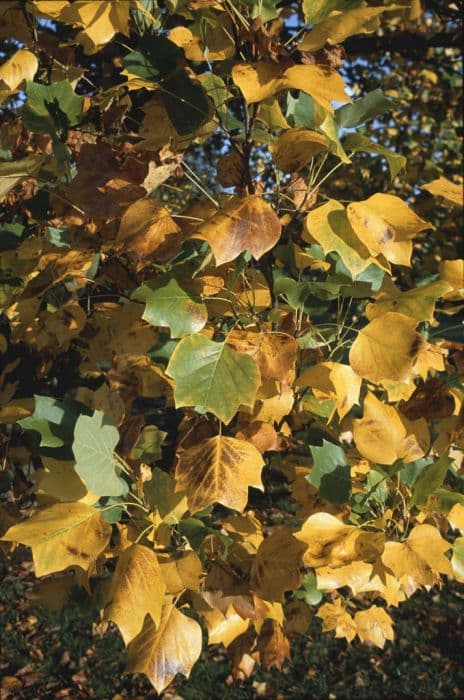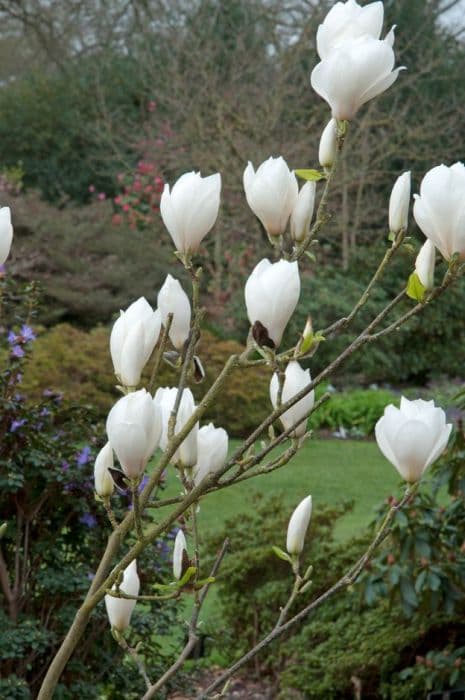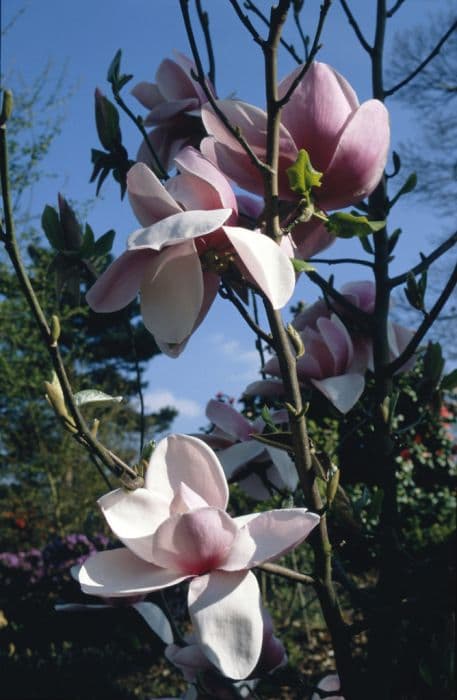Star Magnolia Magnolia stellata 'Jane Platt'

ABOUT
Magnolia 'Jane Platt' is known for its striking floral display. It is a deciduous shrub with a bushy habit, boasting lush green leaves that provide a beautiful backdrop for its flowers. Each bloom is a starry shape with multiple slender petals, arranged in a way that resembles a starburst. The petals are typically a soft pink with deeper pink streaks, creating a romantic and delicate appearance. These flowers emit a light, sweet fragrance that can fill the surrounding air. The branches of Magnolia 'Jane Platt' are elegantly spread, often appearing as if they are reaching outwards, showcasing the spectacular floral display. The plant grows from a central trunk with bark that is smooth and gray, providing a striking contrast to the softness of the blooms. The leaves are obovate with a pointed tip and smooth edges, and they are a dark glossy green, and they turn golden bronze in autumn before falling. This bush's overall structure contributes to its visual impact in the garden, especially when it is in full bloom, and it serves as an excellent focal point or specimen plant.
About this plant
 Names
NamesSynonyms
Star Magnolia, Jane Platt Magnolia
Common names
Magnolia stellata 'Jane Platt'.
 Toxicity
ToxicityTo humans
Star magnolia (Magnolia stellata 'Jane Platt') is generally not considered toxic to humans. There is no widespread evidence suggesting that ingestion of parts of this plant causes poisoning in humans. However, it is generally advised not to eat ornamental plants as they are not intended for human consumption.
To pets
Star magnolia (Magnolia stellata 'Jane Platt') is also not known to be toxic to pets. It does not appear on lists of plants commonly recognized as poisonous to cats, dogs, and other domestic animals. As with humans, although there's no specific toxicity, ingestion of non-food plants by pets should still be discouraged to prevent any potential stomach upset or unforeseen reactions.
 Characteristics
CharacteristicsLife cycle
Perennials
Foliage type
Deciduous
Color of leaves
Green
Flower color
Pink
Height
4 feet [1.2 meters]
Spread
4 feet [1.2 meters]
Plant type
Shrub
Hardiness zones
4
Native area
Japan
Benefits
 General Benefits
General Benefits- Ornamental Value: The Magnolia stellata 'Jane Platt', commonly known as Star Magnolia, boasts beautiful, large pink flowers that add aesthetic appeal to gardens and landscapes.
- Compact Size: This variety remains relatively small, making it suitable for smaller gardens or limited spaces.
- Early Spring Blossoms: Star Magnolia is one of the first plants to bloom in the spring, providing an early burst of color after the winter months.
- Attracts Pollinators: The fragrant flowers attract bees and other pollinators, supporting the local ecosystem.
- Low Maintenance: Once established, Magnolia stellata 'Jane Platt' requires minimal care, making it a good choice for gardeners of all skill levels.
- Tolerates Cold: It is relatively cold-hardy, making it suitable for planting in a range of climates, including cooler regions.
- Versatile Planting Options: Can be planted as a specimen tree, in garden borders, or as part of a mixed shrubbery, offering flexibility in garden design.
- Year-Round Interest: In addition to spring flowers, it has attractive foliage during the summer, and some varieties may have appealing fall color or interesting bark for winter interest.
 Medical Properties
Medical PropertiesThis plant is not used for medical purposes.
 Air-purifying Qualities
Air-purifying QualitiesThis plant is not specifically known for air purifying qualities.
 Other Uses
Other Uses- Magnolia stellata 'Jane Platt' petals can be candied to add an ornate and edible touch to cakes or pastries.
- The wood of the Star Magnolia, being quite hard, can be used in the creation of small wooden objects, such as decorative handles or inlays.
- The bark can sometimes be used in small-scale crafting, especially for creating rustic or naturalistic art pieces.
- Fallen flowers can be used in potpourri blends, mixed with other dried flowers and spices to create a unique fragrance.
- Leaves from the Star Magnolia can be pressed and used in herbarium collections or as a component in botanical artwork.
- The plant's seeds can be used as a natural dye, producing varying hues on fabrics when prepared correctly.
- Dried branches may serve as an interesting and unique addition to floral arrangements or as support structures in larger displays.
- The dense foliage can be used as a natural backdrop in photography, especially in macro and portrait photography to create a lush, green environment.
- Cuttings from the Star Magnolia can be propagated, allowing gardeners to share and exchange with others, promoting biodiversity and plant education.
- Star Magnolia flowers can be floated in large decorative bowls as centerpieces to create a tranquil and aromatic water feature.
Interesting Facts
 Feng Shui
Feng ShuiThe Star Magnolia is not used in Feng Shui practice.
 Zodiac Sign Compitability
Zodiac Sign CompitabilityThe Star Magnolia is not used in astrology practice.
 Plant Symbolism
Plant Symbolism- Perseverance: Star Magnolia is known for its ability to withstand tough conditions, often being one of the first plants to bloom in late winter or early spring, symbolizing endurance and persistence.
- Nobility and Dignity: In ancient China, magnolias were seen as symbols of purity and nobleness, often associated with the elite classes, embodying sophistication and respect.
- Feminine Beauty: With their delicate and showy flowers, magnolias often represent beauty, softness, and grace, traditionally linked to the feminine aspect.
- Longevity and Health: Due to their long lifespan and medicinal properties in certain cultures, magnolias symbolize good health and longevity.
- Love of Nature: The star magnolia's origin in the natural environment and its striking natural appearance can express a deep appreciation and love of nature.
 Water
WaterThe Star Magnolia should be watered regularly to maintain a consistently moist soil environment, especially during its growing season. Young plants need thorough watering once a week, whereas established plants require less frequent watering but should still be done deeply, aiming for about 1 to 1.5 inches of water weekly. Drip irrigation or a soaker hose is a beneficial method to water this plant, as they provide slow, deep watering that reaches the roots without wetting the leaves. During dry spells or hot weather, you may need to water more frequently, while in cooler, wetter conditions, you can reduce the frequency. Always check the soil before watering; it should be slightly moist at a depth of a few inches.
 Light
LightStar Magnolias prefer a location with full sun to partial shade, with protection from harsh afternoon sun to prevent leaf scorch. The ideal spot is one that receives morning sunlight and partial shade during the heat of the day. Avoid deeply shaded areas, as this will reduce flowering and can make the plant vulnerable to pests and diseases.
 Temperature
TemperatureStar Magnolias thrive under a wide range of temperatures, but they prefer a temperate climate. They can tolerate a minimum temperature of around 0 degrees Fahrenheit during dormancy in winter and can handle summer temperatures well into the 90s. The ideal growing temperature for the Star Magnolia would be between 70 and 85 degrees Fahrenheit during its active growth phases in spring and summer.
 Pruning
PruningStar Magnolias typically require minimal pruning, primarily to maintain shape and remove any damaged or diseased wood. The best time for pruning is soon after the tree has finished blooming in late spring, to minimize the impact on flower production for the following year. Light pruning every year or two is generally sufficient to keep the plant healthy and well-shaped.
 Cleaning
CleaningAs needed
 Soil
SoilStar Magnolia thrives in well-draining, rich loamy soil with a pH of 5.5 to 6.5. A mix of garden soil, compost, and peat moss is ideal for providing the necessary nutrients and acidity.
 Repotting
RepottingStar Magnolias are typically outdoor plants, but if potted, young trees need repotting every 2-3 years; mature ones less frequently.
 Humidity & Misting
Humidity & MistingStar Magnolia prefers average to high humidity levels but is adaptable to typical outdoor conditions in most climates.
 Suitable locations
Suitable locationsIndoor
Plant in large container with drainage, bright indirect light, and room for growth.
Outdoor
Choose a sunny spot with well-draining soil and shelter from strong winds.
Hardiness zone
4-8 USDA
 Life cycle
Life cycle'Jane Platt' magnolia begins its life cycle as a seed, typically germinating in spring under adequate warmth and moisture conditions. Seedlings establish a root system and grow their first leaves, entering the vegetative stage as they develop stems and foliage. As the plant matures, usually after several years, it enters the flowering stage, producing fragrant, star-shaped pink blossoms in early spring before the leaves fully expand. Following pollination, usually by beetles attracted to the flowers, the tree sets fruit, which are cone-like aggregates of follicles that mature by late summer and release seeds. The plant continues to grow and may enter a period of dormancy in winter, shedding leaves if it is deciduous in colder climates. This cycle repeats annually as the 'Jane Platt' magnolia reaches maturity, with the potential for a lifespan spanning several decades.
 Propogation
PropogationPropogation time
Spring
The star magnolia 'Jane Platt' is widely cherished for its striking pink flowers and can be propagated through various methods though one of the most popular is through softwood cuttings. This technique is generally performed in late spring or early summer when the plant's new growth is still tender but sufficiently matured. Gardeners select healthy, non-flowering shoots, making cuttings of about 4 to 6 inches (10 to 15 centimeters) in length, ensuring at least two to three leaf nodes are included. The lower leaves are removed, and the cut end is often dipped in rooting hormone to enhance the development of roots. Thereafter, the cuttings are placed in a well-draining rooting medium, such as a mix of peat and perlite, and kept in a humid environment with indirect light until roots have established, which can take several weeks. This method provides a clone of the original plant, preserving its unique qualities.









